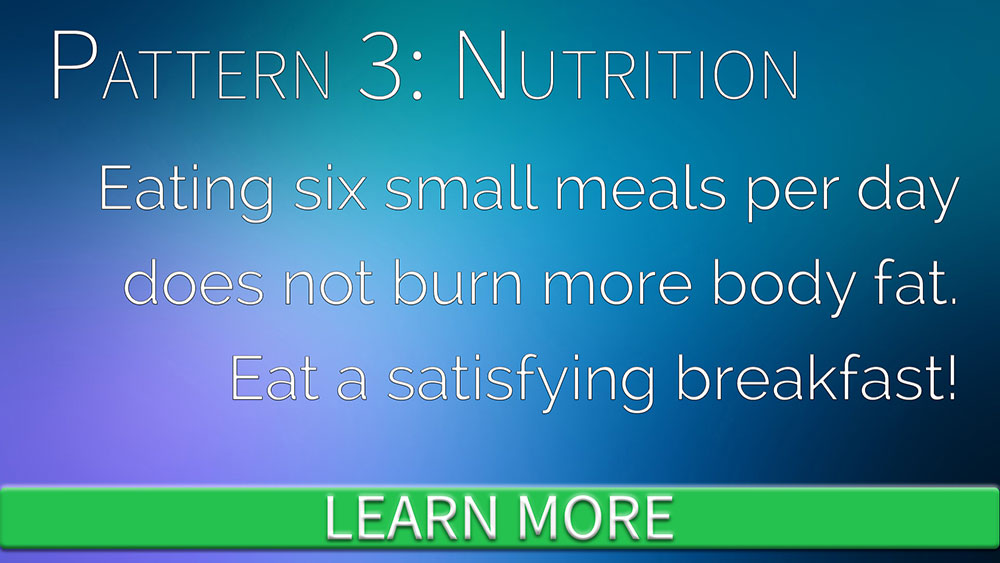The 8 Patterns of Fitness
In this series, I’m going to share some thoughts about the eight patterns of Integre8t Fitness. With these fundamentals in place, you can expect to see enhanced results from your mobile personal training plan. These concepts apply to all fitness and wellness programs. They are the patterns of your lifestyle. Within eight weeks, you can begin to make infinite progress.
#8Patterns1Lifestyle
#8WeeksInfiniteProgress
The doctor of the future will no longer treat the human frame with drugs, but rather will cure and prevent disease with nutrition.
Do you realize there is nothing in our genes that tells us to die? There are genetic codes that tell us how to grow, how to breathe, and how to sleep, but nothing that tells us to die. So why do we? Because we literally rust and decay our bodies from the inside out with poor food and lifestyle choices.
Introduction
The third pattern is nutrition. Food provides the energy, macronutrients, micronutrients and building blocks required to keep you healthy and strong. Our modern world has made eating far more complicated than it needs to. It has become a point of confusion for many people, but there is no mystery. Eat healthful foods in sensible quantities. Focus on meals that are fresh, colorful, and unrefined. They should be free of chemicals and hormones. The ingredient list should be short. You should be able to pronounce each component, and know what they are. Avoid eating chemistry experiments!
If you cannot pronounce the ingredients on the food label, assume they are chemistry experiments that don’t belong in your mouth!
Nutrition labels: Energy
Energy on food labels is described as “calories” (with a small “c”). This is a bit of a misnomer, because our foods contain kilocalories (1 KCAL = 1,000 Calories [with an uppercase “C”]). Those numbers start to look huge on a food label, so the standard is to use the number of “calories.” For example: 100 calories is actually 100 KCAL (or 100,000 Calories), but what really matters is that all Calories contain the same amount of energy. It doesn’t matter which macronutrient they come from. In terms of energy, a Calorie is a Calorie.
“Targeted” Calories
When food or supplement products claim to “target” certain types of calories, that is simply a marketing ploy. Ignore it. What they mean is that the product has more Calories from certain macronutrients as opposed to others. And that part does matter. It matters a great deal! (If you have trouble losing body fat after you have consistently and methodically monitored your calories, you might consider building your own fat burning stack with the recipe I described in a separate blog entry. You find the components for it here.)
Always check the serving size first. All the information on the label is based on the serving size. Many packages contain more than 1 serving.
For example, the serving size for spaghetti is most often 2 ounces (56 grams) uncooked, or 1 cup (0.24 liters) cooked. If you eat 2 cups (0.48 liters) at a meal, you are eating 2 servings. That is 2 times the amount of the calories, fats, and other items listed on the label.
Calorie information tells you the number of calories in 1 serving. Adjust the number of calories if you eat smaller or larger portions. This number helps determine how foods affect your weight.
Macronutrients
Macronutrients are the energy sources within foods. Nutritionists call them Carbohydrates, Proteins and Fats. In their natural states, all of them are essential, so eliminating one (or even worse, two!) will likely undermine your nutrition and wellness goals. An example of this includes an outright lie started in the 1960s. It persists to this day, and says that you should avoid eating fats. My own addiction to sugar began when I was a young dancer trying to avoid all fats at all costs.
To make fat-free foods palatable, something had to take the place of the removed fat. Those replacements were salt, refined carbohydrates in the form of simple sugars, artificial sweeteners, and hydrogenated oils. This has led to an epidemic of obesity. Heart disease, metabolic disorders, tooth decay, and cancer have become major public health concerns. Mental, emotional, and psychological illnesses are aggravated by these chemicals. Then there’s the myriad other cascading risk factors that come with all these diseases. Something to consider is that although all of the macronutrients are essential to health, each individual person has varying needs. Each person thrives at a unique energy quantity and macronutrient ratio.
Micronutrients
Micronutrients are the vitamins, minerals, trace metals, and other components of food that are essential to health, but which do not provide energy directly. You need them to process the Calories you consume. They are necessary for movement, immune system maintenance, and hormone production. They play a role in every process in your body, so be sure to eat a wide variety of all the food groups. Fruits and vegetables are dense with micronutrients. Whole grains and legumes provide heart healthy components and slow digesting carbohydrates. Nuts and seeds contain healthy fats, so do plant and fish oils, as well as natural butter. And don’t neglect protein.
The micronutrients in these natural foods come in the proper ratios to maximize absorption, and they compliment each other to create an ideal nutrition plan. (To quickly make shakes, smoothies, and soups that include all the components of complete nutrition, consider buying The Nutri Ninja blender on Amazon.)
I love my Nutri Ninja Pro!
This style of eating is more balanced than one that requires you to completely cut out carbs, grains, dairy, or meat. Additionally, the 40-30-30 macronutrient ratio with regular meals throughout the day can help stabilize blood sugar levels… nutrient deficiencies were far less likely on a Zone-style diet than they were on other popular weight loss diets.
The 40:30:30 principle
A simple macronutrient ratio that serves as a broad blanket default is the 40:30:30 principle. Your needs may vary, but this is one of the common nutrition suggestions. Let’s keep the numbers simple: You want a 100-calorie snack. Look to see if there are 40 calories from carbohydrate, 30 calories from protein, and 30 calories from fat. The label should list this as ~10 grams of carbohydrates, ~8 grams of protein and ~3 grams of fat. Some fiber would be awesome. Scale this up or down for the total calories you intend to consume.
Carbohydrates provide energy and recovery from exercise. You need protein to build muscle and repair or replace other tissues and cells in your body. Fat is essential to maintain your nervous system, and it moves fat soluble vitamins throughout your body. Each macronutrient has many other functions, but this is a good short list. Also, try to include all three macronutrients together simultaneously at each meal, because all of them help to use the others more efficiently.
Look for fresh foods around the sides of the grocery store
(Note: Foods on the aisles tend to be highly processed)
Check food labels for energy and nutrition information
(Note: Ingredients are listed in order by largest volume to smallest)
Macro ratios ensure complete nutrition
(Note: Avoid diets that forbid entire categories of nutrition, unless instructed by your doctor)
4 Sessions per Month
Save $100- Free Evaluation
- $100 per session
- 1 session/week
8 Sessions per Month
Save $140- Free Evaluation
- $95 per session
- 2 sessions/week
12 Sessions per Month
Save $220- Free Evaluation
- $90 per session
- 3 sessions/week
Recent Updates

Glycemic Index vs Glycemic Load
This score indicates how damaging a food will be to your blood sugar levels. Foods that score 0-55 are rated low impact (and thus presumed to be better for diabetics and those looking to maintain healthy weight and/or body fat ratios), but this is not the whole picture.

Caffeine: 14 better options to ease SAD
Nearly a year ago to the dot, I wrote an article about Seasonal Affective Disorder (SAD), but there I focused on the importance of getting access to a full range spectrum of light. Here I’d like to focus on caffeine and sleep’s effect on SAD. I’ll also offer suggestions for what to do to help you feel better on the dark days.

Avoid fish oil supplements
I don’t generally promote supplements. Most of them play to specific, isolated points of medical research to serve as a magic pill. One remarkable example of this is fish oil.



